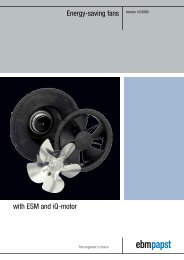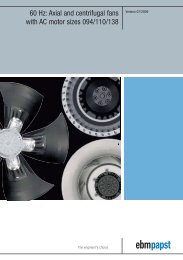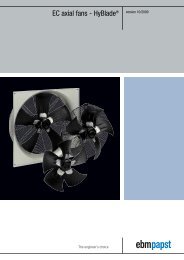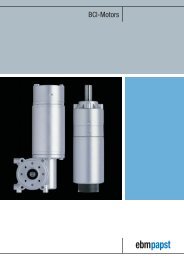Download [PDF] 2.1 MB - ebm-papst UK
Download [PDF] 2.1 MB - ebm-papst UK
Download [PDF] 2.1 MB - ebm-papst UK
Create successful ePaper yourself
Turn your PDF publications into a flip-book with our unique Google optimized e-Paper software.
AXIAL FANS<br />
Figure 2: Sound power (left) and spectra<br />
(right) of two axial fans with identical external<br />
dimensions operated in the same way<br />
tonal noise<br />
fan 2<br />
comparison sound power spectrum<br />
tonal noise<br />
fan 1<br />
LEGEND<br />
fan caracteristic curve<br />
fan 1<br />
fan 2<br />
sound power spectrum<br />
frequency [Hz]<br />
inflow conditions. For example, a fan may have a<br />
low blade passing noise under ideal conditions but<br />
this may be amplified in an unfavourable installation<br />
situation [5]. A non-uniform flow developing<br />
immediately upstream of the inlet (e.g. as a result<br />
of fitted components causing the formation of<br />
vortices which strike the impeller) will give rise to<br />
blade passing noise. Such an effect can be alleviated<br />
by way of suitable flow routing or the use of<br />
grilles to break up these coherent structures and<br />
create a more homogeneous turbulent inflow.<br />
There is a need to develop ever quieter fans to<br />
satisfy increasing requirements and the demand<br />
for more and more compact system designs.<br />
Lower speeds and aerodynamic components such<br />
as winglets and trailing edges can help to achieve<br />
this development goal. Adaptation to the system<br />
as a whole is however often required to obtain<br />
ideal results. Operating and installation conditions<br />
can have a significant effect on the acoustic characteristics<br />
of the entire system.<br />
Figure 3: Flow of an axial fan with winglets (left) and trailing edges Series fan (right)<br />
Author is engineer Michael Schmitz, Head of Central<br />
Research and Development at <strong>ebm</strong>-<strong>papst</strong> St. Georgen<br />
You would like more information on this topic Please address<br />
your question to: Michael.Schmitz@de.<strong>ebm</strong><strong>papst</strong>.com<br />
Bibliography<br />
[1]: L. Bommes, J. Fricke, K. Klaes, Ventilatoren, Vulkan Verlag, 2002<br />
[2]: M.B. Schmitz, G. Eimer and H. Schmid. Design and Test of a<br />
Small High Performance Diagonal Fan. Proceedings of ASME<br />
Turbo Expo 2011, Vancouver, Canada<br />
[3]: M. Stadler, M.B. Schmitz, P. Ragg, D.M. Holman and R. Brionnaud,<br />
Aeroacoustic Optimization for Axial Fans with the Lattice-Boltzmann<br />
Method, Proceedings of the ASME Turbo Expo<br />
2012, Copenhagen, Denmark<br />
[4]: M. Stadler, M.B. Schmitz, W. Laufer, P. Ragg, Inverse Aeroacoustic<br />
Design of Axial Fans Using Genetic Optimization and<br />
the Lattice-Boltzmann Method, Proceedings of the ASME<br />
Turbo Expo 2013, St. Antonio, USA<br />
[5]: M. Sturm, T. Carolus, Large Scale Inflow Distortions as a<br />
Source Mechanism for Discrete Frequency Sound from Isolated<br />
Axial Fans, Proceedings of AIAA Aeroacoustics 2013, Berlin,<br />
Germany<br />
techmag 02°2013<br />
11


![Download [PDF] 2.1 MB - ebm-papst UK](https://img.yumpu.com/36174834/11/500x640/download-pdf-21-mb-ebm-papst-uk.jpg)


![Compact fans for AC and DC [PDF] - ebm-papst](https://img.yumpu.com/48610592/1/184x260/compact-fans-for-ac-and-dc-pdf-ebm-papst.jpg?quality=85)
![Download [PDF] 9.8 MB - ebm-papst Automotive & Drives](https://img.yumpu.com/47171334/1/184x260/download-pdf-98-mb-ebm-papst-automotive-drives.jpg?quality=85)

![Download [PDF] 3.1 MB - ebm-papst UK](https://img.yumpu.com/40847594/1/185x260/download-pdf-31-mb-ebm-papst-uk.jpg?quality=85)

![Download [PDF] 2.3 MB - ebm-papst UK](https://img.yumpu.com/35271378/1/190x252/download-pdf-23-mb-ebm-papst-uk.jpg?quality=85)
![Download [PDF] - ebm-papst UK](https://img.yumpu.com/35139755/1/190x135/download-pdf-ebm-papst-uk.jpg?quality=85)

![Download [PDF] 1.5 MB - ebm-papst UK](https://img.yumpu.com/30021941/1/184x260/download-pdf-15-mb-ebm-papst-uk.jpg?quality=85)
![DC fans - specials [PDF] 1.2 MB](https://img.yumpu.com/28121898/1/184x260/dc-fans-specials-pdf-12-mb.jpg?quality=85)
